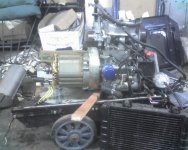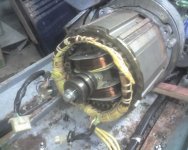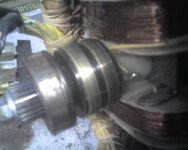dcyrilc
Elite Member
Got the manual ordered yesterday. I should have it sometime next week.



Hallo dcyrilc , hallo to washington,
first of all I will thank you for that brilliant posting about your successful job on the EX5500 ! :thumbsup: And for your scary pix too ! :confused2:
(sorry for my lousy english but I am a German "Kraut", writing from Berlin, Germany )
Since my EX5500 Gene unfortunately will not listen to my prayers anymore denieing all power output now ( no green pilot lamp, no voltage on voltmeter, no power to read on the screw contacts behind the receptacle panel ( white and brown cables on contacts from rotor/stator ) I am getting prepared to go into this job too. ( Good grieff ! )
Therefore I have some questions if that is ok here :
1
Do you know the Honda Part No. of those rotor/stator brushes ?
I will try to order them here in Germany / Europe.
2
And do you have any idea where I might get a service and part manual for the --> stator/rotor with exact drawings of all the parts ?
(not for manual of the EX5500 itself)
3
Do you know who manufactured the rotor/stator ?
It's not Honda , and not GE ?
4
Did you try the "flashing" idea to wake up the alternator with an electric drill to reanimate the magnetic field of the stator before you disambled your babe ?
5
And do you think, that it could be enough to dissamble the right cover and the radiator, to get to the rotor/stator to change the brushes ?
Or do I really have to strip it all like shown on your breathtakin' images ?
Would it be really neccessary to remove the stator/rotor complete off frame, to open and change the brushes ?
I hope that my 5 questions are not to stupid and I would be more than happy to hear from you .
Many thanx in advance and
Best greetings and Cheers
from
Michael , Berlin Germany (Gardener)
mail : xpcx [at] kainerda. de
You may want to try this prior to starting on major repairs.
I've never had to do that but here's a link about a rather easy thing to
try:
PER Notebook - Generator Field Flashing
Field Flashing of Portable Generators
This tip comes from the Briggs & Stratton Customer Education Department.
As an alternative to flashing a rotor winding with a battery applied to
the brushes, an electric drill may be used. Follow these steps to flash
the generator:
Plug the electric drill into the generator receptacle. (Cordless drills
do not work)
If the drill is reversible, move the direction switch to the forward
position.
Start the generator
While depressing the trigger on the drill, spin the drill chuck in
reverse direction. (A neighbor tried this and used a small wooden dowel that will break easily and a batterry drill to spin the electric drill in reverse)This will excite the field and the generator will now produce electricity. If spinning the chuck one direction does not work, try spinning the chuck in the other direction as you may have the
reverse switch positioned backwards.
Use caution not to get your hand or other materials caught in the chuck.
As soon as the field is excited, the generator will produce power and
the drill will turn on.
The reason this works is because the electric motor
in the drill will act as a small generator when spun backwards. The magnets in the drill's
motor induce a voltage into the motor windings, which is fed back
through the trigger, cord and into the generators receptacle. From there
it goes into the power winding of the stator. The voltage going through
the power winding creates a magnetic field, which is intensified due to
the iron core of the stator laminations. The rotor intersects this
magnetic field as it is spun past the power winding, thus inducing a
voltage in the rotor winding. Once current flow is present in the rotor
winding the rotor has been flashed.
If flashing the field does not make the generator work, you may have
additional problems, besides a lack of magnetism in the rotor. Further
testing will be needed. Hopefully, this will give a simple way to field
flash your generator if needed